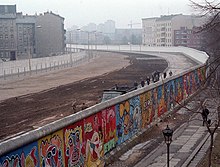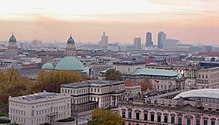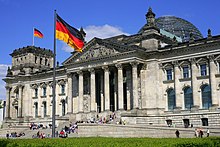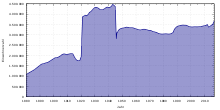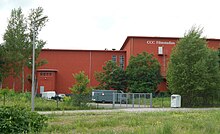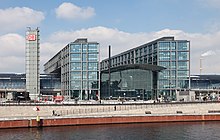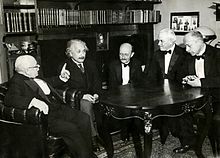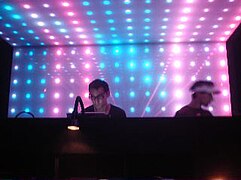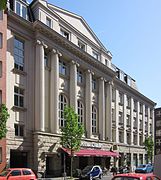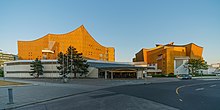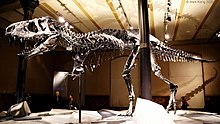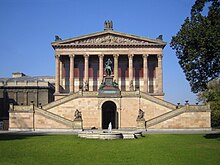Berlin
Berlin (in German, Berlin, pronounced/b participant.(![]() listen)) is the capital of Germany and one of the sixteen German federated states. It is located northeast of Germany. Spree, Havel, Panke, Dahme and Wuhle rivers flow through the city.
listen)) is the capital of Germany and one of the sixteen German federated states. It is located northeast of Germany. Spree, Havel, Panke, Dahme and Wuhle rivers flow through the city.
With a population of 3.77 million inhabitants, Berlin is the most populous city in the country and in Central Europe, as well as the first city in population and the fourth urban agglomeration among the countries of the European Union.
It was successively the capital of the Kingdom of Prussia (1701-1918), of the German Reich (1871-1919), of the Weimar Republic (1919-1933) and of the Third Reich (1933-1945). After World War II, the city was divided; the eastern part of the city became the capital of the German Democratic Republic, while the western part of the city became an exclave of the Federal Republic of Germany within East Germany.
Berlin has around 2,000 active tech start-ups (2018), most of which are focused on software, technology and innovation for start-ups, biotech, e-commerce, mobility and cybersecurity. This is how it is positioned as the second largest entrepreneurship center in Europe.
Berlin is a global city and a world-class cultural and artistic center. The city's 40 universities make up the highest concentration of higher education institutions in all of Germany.
Toponymy
Berlin lies east of the Elbe River, on the former eastern border of the East Frankish kingdom. These regions were inhabited by Slavic tribes; for this reason, most of the cities and towns in the northeast of present-day Germany have Slavic names and the region itself was called Germania Slavica. Typical suffixes for Germanized place names of Slavic origin are -ow, -itz, -vitz, -witz, -itzsch, and -in. The prefixes are usually Windisch and Wendisch. The name of Berlin therefore has Slavic roots. It is related to the words berl or birl, which in Polabo meant "uncultivable land" or "uninhabited land", respectively. It is also derived from the combination of berl (in this case with the possible meaning of swamp) plus the aforementioned Slavic locative suffix -in, which indicated a place; that is, "swampy place", a presumption strengthened because it is generally named with an article: Der Berlin.
The popular German etymology associates it with the bear on the city's coat of arms, since in German Bär, pronounced [ber], means bear. From there, its foundation was attributed to Albert the Bear (Albrecht den Bären).
Of the twelve districts of Berlin, five have a partially Slavic name: Pankow (the most populous), Steglitz-Zehlendorf, Marzahn-Hellersdorf, Treptow-Köpenick and Spandau (Spandow until 1878).
History
The earliest evidence of settlement in the area of present-day Berlin is a house foundation dating to 1174, found in excavations in Berlin Mitte, and a wooden beam dating to about 1192. The earliest written records of Towns in the area of present-day Berlin date from the late 12th century century. Spandau is first mentioned in 1197 and Köpenick in 1209, although these areas did not join Berlin until 1920.
The central part of Berlin can be traced back to two cities: Cölln is first mentioned in a document from 1237, and a document from 1244 refers to Berlin, across the Spree in what is now called the Nikolaiviertel. the traditional founding date is 1237. Over time, the two cities formed close economic and social ties, benefiting from basic rights on the eastern trade routes from Bruges to Novgorod. In 1307, they formed an alliance with a common foreign policy.
The city entered history in 1415, when it was chosen as the capital of the Margraviate of Brandenburg, then one of the many mosaic states that made up the Holy Roman Empire.
In 1759, East Prussia was in the hands of the Russians who had captured Berlin in the Seven Years' War. Russia withdrew in 1762 because, on the Empress's death, her successor, Peter III, who admired Frederick the Great of Prussia, signed a peace treaty.
Because Brandenburg is part of the Kingdom of Prussia, Berlin became the capital of the German Empire (in 1871) when Prussia achieved the unification of Germany, after first defeating Austria in the Seven Weeks War (1866) and then finishing with the Second French Empire by defeating its army in the Franco-Prussian War. Since then it experienced a considerable demographic increase, going from 824,484 inhabitants in 1871 to 1,888,313 in 1900 and to 4,024,165 in 1925. The city became a cultural, architectural and financial center worldwide.
Capital of Nazi Germany, Berlin reached its demographic peak in 1939 with 4,338,756 inhabitants. Adolf Hitler planned large-scale urban works by Albert Speer and the renaming of it as Germania, which were not carried out due to the start of World War II, during which most of the city was destroyed by aerial bombardments carried out by the British Royal Air Force and the American USAAF, to which was added the battle of Berlin against the Soviet Army. Thousands of civilians died as a result of the bombing and ground battles. After the defeat of the Nazi regime, Berlin was divided into four sectors under the administration of the four allies.
In 1948, the three western sectors (West Berlin), which were under the respective control of the United States, France and the United Kingdom, were reunited within the framework of the Federal Republic of Germany (FRG), to which the Union The Soviet retaliated with the blockade of West Berlin and the creation of the German Democratic Republic (GDR) in 1949, with its capital in East Berlin. This blockade failed thanks to the airlift maintained by Western forces from the FRG.
In 1961, the GDR built the so-called Berlin Wall to separate the two parts of the city, and in fact to isolate West Berlin from the GDR, in order to stop the emigration of Germans from the East to the West. The wall, which had a total of 144 km, was one of the best-known symbols of the Cold War and the partition of Germany. Many people died trying to get past the heavy surveillance of the GDR border guards as they made their way to the western sector. The exact number of victims is subject to dispute and is not known for sure. The figures of the different versions oscillate between 86 and 238 deaths.
Many West Berliners also left the city due to feelings of insecurity or for economic reasons: the isolated city located in territory of Soviet influence, although massively subsidized, could not offer the same opportunities as the rest of the country, which which contributed to the decrease in the number of inhabitants.
The Berlin Wall fell on November 9, 1989, when the GDR government accepted the free movement of citizens between the two parts of the city. Almost a year later, the GDR disappeared, annexed in fact to the FRG, which in 1990 moved its capital from Bonn to Berlin, thereby giving the population of the defunct republic entry into the EEC.
Reunification
Many historic buildings and sites such as Potsdamer Platz and the Reichstag have been renovated. Many of the world's best architects build or rebuild a whole range of public and private buildings. Urban reorganization activities are complemented by urban planning instruments of social urban planning and other European programs, such as URBAN II. For example, the district of Prenzlauer Berg, together with those of Friedrichshain and Weissensee, was included in the aid program for the development of the European Union, as part of this EU URBAN initiative for urban areas. The characteristic of this concept of planned financing is the interconnection between the different aspects of the program: social, urban, economic. This district was the largest coherent urban redevelopment area in Europe. In 2006 Berlin was chosen as a Creative City by Unesco.
Construction of the city's Imperial Palace, which was destroyed in 1950, was expected to be completed by 2020, but was delayed by the COVID-19 pandemic. This project contemplates the creation of a large cultural center inside the new building, whose façade will be an exact copy of the original.
Geography
The exact geographical location of the Berlin city hall is 52º 31' 12" north latitude, 13º 24' 36" east longitude. The greatest extension in an east-west direction is about 45 km, and in a north-south direction about 38 km. The area of the city is approximately 892 km². Berlin is completely surrounded by the eastern German state of Brandenburg, approximately 70 km west of the Polish border. The city is one of the conurbations of the Federal Republic.
Berlin lies in a region formed during ice ages in the Urstromtal (former channel) of Warsaw-Berlin, between the Barnim and Teltow plateaus. The historic center of Berlin is located at the narrowest point of the River Spree as it passes through the Urstromtal. In Spandau, Berlin's westernmost district, the Spree empties into the Havel River, which runs north-south through western Berlin. The course of the Havel is often likened to a seascape, its largest expansions being Lake Tegel and the Großer Wannsee.
Located in the northeast of Germany, Berlin covers a total area of 892 km² and is divided into 12 districts or neighborhoods. These districts are Mitte, Friedrichshain - Kreuzberg, Pankow, Charlottenburg - Wilmersdorf, Spandau, Zehlendorf - Steglitz, Schöneberg - Tempelhof, Neukölln, Treptow - Köpenick, Marzahn - Hellersdorf, Lichtenberg and Reinickendorf.
Climate
Berlin has an oceanic climate (Köppen climate classification: Cfb) the eastern part of the city is slightly influenced by a humid continental climate (Köppen climate classification: Dfb); especially in the 0 °C isotherm, one of the changes being the annual precipitation according to the air masses and the greater abundance during a period of the year. This type of climate presents moderate but sometimes hot summer temperatures (because they are semi-continental) and cold but not harsh winters most of the time.
Due to its transitional climatic zones, frost is common in winter and there are larger temperature differences between seasons than are typical of many oceanic climates. In addition, Berlin is classified as a temperate continental climate (Dc) under the Trewartha climate scheme, as are the suburbs of New York, although the Köppen system classifies them into different types.
Summers are hot and sometimes humid with average high temperatures of 22 to 25 °C and lows of 12 to 14 °C. Winters are cool with average high temperatures of 3 °C and minimum temperatures of -2 to 0 °C. Spring and fall are generally cool to mild. The built-up area of Berlin creates a microclimate, with heat being stored by the city's buildings and pavement. Temperatures can be 4 °C higher in the city than in the surrounding areas. The annual precipitation is 570 mm with moderate rains throughout the year. Snowfall occurs mainly from December to March. The hottest month in Berlin was July 1834, with an average temperature of 23.0 °C, and the coldest was January 1709, with an average temperature of -13.2 °C. The wettest month on record was July 1907, with 230 mm of rain, while the driest were October 1866, November 1902, October 1908, and September 1928, all with 1 mm of rain.
| Month | Ene. | Feb. | Mar. | Open up. | May. | Jun. | Jul. | Ago. | Sep. | Oct. | Nov. | Dec. | Annual |
|---|---|---|---|---|---|---|---|---|---|---|---|---|---|
| Temp. max. abs. (°C) | 15.0 | 17.0 | 23.0 | 30.0 | 33.0 | 38.6 | 38.8 | 35.0 | 32.0 | 25.0 | 18.0 | 15.0 | 38.8 |
| Average temperature (°C) | 2.9 | 4.2 | 8.5 | 13.2 | 18.9 | 21.8 | 24.0 | 23.6 | 18.8 | 13.4 | 7.1 | 4.4 | 13.4 |
| Average temperature (°C) | 0.5 | 1.3 | 4.9 | 8.7 | 14.0 | 17.0 | 19.0 | 18.9 | 14.7 | 9.9 | 4.7 | 2.0 | 9.6 |
| Temp. medium (°C) | −1.9 | −1.5 | 1.3 | 4.2 | 9.0 | 12.3 | 14.3 | 14.1 | 10.6 | 6.4 | 2.2 | -0.4 | 5.9 |
| Temp. min. abs. (°C) | -26.1 | -25.0 | -13.0 | -4.0 | -1.0 | 4.0 | 7.0 | 7.0 | 0.0 | -7.0 | -9.0 | -24.0 | -26.1 |
| Rains (mm) | 42.3 | 33.3 | 40.5 | 37.1 | 53.8 | 68.7 | 55.5 | 58.2 | 45.1 | 37.3 | 43.6 | 55.3 | 570.7 |
| Rainy days (≥ 1.0 mm) | 10.0 | 8.0 | 9.1 | 7.8 | 8.9 | 7.0 | 7.0 | 7.0 | 7.8 | 7.6 | 9.6 | 11.4 | 101.2 |
| Hours of sun | 46.5 | 73.5 | 120.9 | 159.0 | 220.1 | 222.0 | 217.0 | 210.8 | 156.0 | 111.6 | 51.0 | 37.2 | 1625.6 |
| Source No. 1: World Meteorological Organization (UN) | |||||||||||||
| Source No. 2: HKO | |||||||||||||
Natural spaces
Berlin has 2,500 public parks. More than 300 km², a third of its surface, is occupied by green areas, half of which are forests.
The Permanent Forest contract was a 1915 agreement between Berlin and Prussia for the acquisition of forest around the city. The term Permanent Forest, as part of the name of the contract, refers to its purpose of remaining unchanged over time.
In contrast to the central and eastern parts of the city, which are densely built-up, the western parts open up to wooded green areas, with lakes fed by the rivers Spree and Havel, offering visitors entertainment venues and Natural spaces.
Tiergarten is a large park located in the center of the city. In its early years it was a hunting area and later it became a large green area for the use and enjoyment of Berliners.
The Botanical Garden is one of the largest and best known in Europe; It also has an important collection of prepared plants and a specialized library.
Urbanism
- Berlin Wall: There are still some sections of this construction that divided not only the city of Berlin, but also the world into two diametrically opposed ideologies. In Mühlenstraße you can see a stretch of more than one kilometer of this relic of the past. Also preserved in good condition Checkpoint Charlie, which was one of the access points for foreigners in East Berlin and of clandestine escape of some RDA inhabitants. Currently next to the Checkpoint Charlie is a museum dedicated to the history of the wall and to those who tried to cross it in various ways.
- Brandenburg Gate: Monument located a few meters from the collapsed wall, in the land of no one between the wall itself and the police headquarters and watch towers (Volkspolizei) of the GDR; today it is symbol of the reunification of the country.
- Reichstag: Since 1999 it is the seat of the federal parliament, called Bundestag. In its reconstruction, only the outer walls were left; the interior is completely new. Its glass dome is accessible to the public and offers a magnificent panoramic view of the city, especially at night.
- Siegessäule (Column of Victory): 69 m high monument located in the Tiergarten Park that commemorates three German victories in the centuryXIX. It is crowned by a statue of Niké, the Greek goddess of victory. You can access to your cusp, where you get a privileged view of the city. It was popularized by being the meeting place of angels in the movie So far, so close! of the German director Wim Wenders.
- Alexanderplatz: In the center of ancient East Berlin is this great square where the former Communist government of the RDA left its most visible footprint. Near this square is the TV tower of Berlin, 368 m high, which can be seen from almost any point of the city. Built in the 1960s, the tower has a panoramic circular restaurant that revolves over itself and from which you can see a wide panoramic view of the city. In ancient times the allegorical statue of Berolina was lifted.
The immediate vicinity of Alexanderplatz is full of monuments and large old buildings, squares and shops of all kinds. Among the monuments, the Town Hall (Rotes Rathaus) and the Berlin (Protestant) Cathedral (Berliner Dom) stand out.; both buildings have a particular architecture.
- Potsdamer Platz: In the heart of West Berlin is the new Potsdamer Platz, which in the 1920s was one of the most popular points in all of Europe. From the fall of the wall, it became a huge construction project, in which today you can find modern shopping centers and skyscrapers that mark a new era for Berlin.
- Unter den Linden ('under the tiles') is the main boulevard of the city. It begins in the square of Paris on the east side of the door of Brandenburg, where are the Academy of Art, the well-known Hotel Adlon and the embassies of France and the United States. From this square it runs 1.5 km east to the bridge called Schlossbrücke, which serves as a union with the Museum Island and the East Berlin center. In a square adjacent to this avenue Unter den Linden is found Berlin Cathedral (Catholic), right between Opera Staatsoper Unter den Linden (one of the three that has the city) and the building known as the Kommodeand is dedicated to St. Eduviges.
- Friedrichstraße: Former cultural, economic and commercial centre in Berlin. He is currently trying to regain his importance in the city.
- Kaiser-Wilhelm-Gedächtniskirche: Church located in the West Berlin Centre (old West Berlin), suffered the bombing of the Allies during the Second World War. To these bombings only survived a large tower that has been preserved without restoring to remember the consequences of the war, harboring on its upper part the Freiheitsglocke (Campana de la libertad) and was annexed to a modern building for the parish. In fact, this church is also known as "the church in memory of the futility of war." The entrance to the church is free and opens its doors from 9 am to 7 pm, every day of the week.
- Holocaust Memorial: The 2711 concrete blocks recall the Jewish Holocaust committed by Nazi Germany. This monument, designed by the architect Peter Eisenman, is located a few meters from the Brandenburg Gate.
- The zoological garden in Berlin (Zoologischer Garten Berlin) is one of the largest zoos in Germany and with the largest number of animal species in a zoo in the world.
Administration
National Government
The Berlin Wall falls on November 9, 1989 when the GDR accepted the free movement of citizens between the two parts of the city. The following year, with the German Reunification, the GDR disappeared, annexed in fact in the FRG, which moved its capital from Bonn to Berlin in 1990, thereby giving the population of the former republic entry into the European Union (EU).
Berlin is once again the center of political power and numerous buildings are built to once again house the country's main institutions. However, it is the restoration of the Reichstag building that best symbolizes the rebirth of the city.
For Berlin to become the capital of Germany by law again, it was necessary to hold a vote in the Bundestag in June 1991, where it was decided to transfer the institutions from Bonn to Berlin. The transfer of the federal government and the Chancellery took place in 1999.
According to the German constitution, the president of the German Parliament has police powers over the building of the German Parliament, and over any other place where the members of the Parliament meet. These are exercised through the German Federal Parliament Police.
Municipal government
Following German reunification, several enthusiasts have launched the project to officially return the name of Prussia to the region formed by the States of Berlin and Brandenburg. In a referendum held in 1996, the majority of the inhabitants of Brandenburg and East Berlin spoke out against the merger of the two states, while those of West Berlin did so in favor.
Berlin's public debt multiplied between 1992 and 2001, from 10 billion euros to 61.9 billion euros. This development led to a change in the regional government and the replacement of the conservative Eberhard Diepgen by the social democrat Klaus Wowereit, who was the first leader of his party to agree to a government in coalition with the Party of Democratic Socialism (PDS), heir to the United Socialist Party of Germany of the GDR. The management of this "red-red government" it was marked by the continuing need to cut costs, as well as by an economic policy focused on increasing Berlin's attractiveness by investing in culture—particularly popular culture—thus contributing to the city's reputation for dynamism.
In 2011 Wowereit was re-elected mayor, but this time in coalition with the CDU. In 2014, Mayor Wowereit resigned from his position worn by the mismanagement of Berlin's new airport and was replaced by Michael Müller, who served until 2021. Following the 2021 Berlin state election, Müller was succeeded by Franziska Giffey, who formed a government coalition between the SPD, Alianza 90/Los Verdes and Die Linke.
On the other hand, the political importance of Berlin within the European Union was confirmed by the German presidency of the Council of the Union in 2007, during which the "Berlin Declaration" .
Administrative districts
| Barrio | Inhabitants | Surface (km2) | Inhabitants (km2) |
| Mitte | 361.986 | 39,47 | 9171 |
| Friedrichshain-Kreuzberg | 271.856 | 52,29 | 5199 |
| Pankow | 391.204 | 103.01 | 3793 |
| Charlottenburg-Wilmersdorf | 314.565 | 64.72 | 4863 |
| Spandau | 235.309 | 91.91 | 2561 |
| Steglitz-Zehlendorf | 290.117 | 102.50 | 2829 |
| Tempelhof-Schöneberg | 338.185 | 53,09 | 6375 |
| Neukölln | 318.026 | 44,93 | 7078 |
| Treptow-Köpenick | 256.915 | 168.42 | 1532 |
| Marzahn-Hellersdorf | 258.569 | 61,74 | 4183 |
| Lichtenberg | 280.905 | 52,29 | 5390 |
| Reinickendorf | 257.193 | 89.46 | 2879 |
Security
The Landespolizei (Polizei Berlin) refers to the police forces of the Länder, the federal states of Germany.
The Federal Police (Bundespolizei) is the national police force of the Federal Republic of Germany. It is subordinate to the Federal Ministry of the Interior (Bundesministerium des Innern und für Heimat).
Twin cities
Berlin maintains official alliances with 18 cities. Town twinning between Berlin and other cities began with Los Angeles in 1967. The East Berlin partnerships were canceled at the time of German reunification and later partially reinstated. During the Cold War, the associations reflected existing blocs, with West Berlin associated with capitals in the West, while East Berlin was associated mostly with Warsaw Pact cities and their allies.
There are several joint projects with other cities, such as Belgrade, Copenhagen, Helsinki, Johannesburg, Shanghai, Seoul, Sofia, Sydney and Vienna. Berlin participates in international city associations such as the Union of Capitals of the European Union, Eurocities, the Network of European Cities of Culture, Metropolis, Summit Conference of the World's Most Important Cities, the Conference of World Capital Cities. The cities officially twinned with Berlin are the following:
|
|
|
Demographics
A tenth of Berlin's population is made up of citizens of other countries. Many of these immigrants arrived as temporary workers, although they eventually settled in the city. The most important group of these workers is that of the Turks, followed by Italians, Poles, Russians and other subgroups from the states of the former Yugoslavia and various African and Asian nations.
Berlin's population has grown rapidly since the end of World War II, when it had fallen to just 2,300,000. Today Berlin has a population of 3,400,000. Factors contributing to the population growth included the return of residents evacuated during the war, a flow of East Germans to West Berlin, and large numbers of people who came as immigrants. Between 1957 and 1990, young people from the Federal Republic of Germany had the opportunity to escape military service by living in West Berlin. Since German reunification, hundreds of thousands of new arrivals have arrived in the city.
Approximately 60% of the population of Berlin does not profess a religion (2010). About 19.8% of the population belong to the Evangelical Church, 9.4% to the Catholic Church and 3% to other Christian denominations. Other religions are practiced by small segments of the population, mainly Islam at 8.8%.
German is official and is mainly spoken in Berlin (where it is the mother tongue of more than 70% of the population).
Population
Main countries (2020):
- Germany
 Germany 2 984 036
Germany 2 984 036 - Turkey
 Turkey 98 814
Turkey 98 814 - Poland
 Poland 55 593
Poland 55 593 - Syria
 Syria 40 574
Syria 40 574 - Italy
 Italy 31 355
Italy 31 355 - Bulgaria
 Bulgaria 30 645
Bulgaria 30 645 - Russia
 Russia 26 913
Russia 26 913 - Romania
 Romania 24 463
Romania 24 463  United States 22
United States 22- Serbia
 Serbia 20 154
Serbia 20 154  France 19 590
France 19 590- Vietnam
 Vietnam 19 475
Vietnam 19 475 - United Kingdom
 United Kingdom 16 092
United Kingdom 16 092 - Spain
 Spain 14 840
Spain 14 840 - Greece
 Greece 14 458
Greece 14 458  India 14 161
India 14 161- Croatia
 Croatia 13 890
Croatia 13 890 - Afghanistan
 Afghanistan 13 626
Afghanistan 13 626 - China
 China 13 155
China 13 155 - Bosnia and Herzegovina
 Bosnia and Herzegovina 12 398
Bosnia and Herzegovina 12 398 - Austria
 Austria 11 838
Austria 11 838
Religion
More than 60% of Berlin's residents have no religious affiliation, for this reason Berlin is sometimes called the "European Capital of Atheism". The predominant religion is Protestantism (18.7% of the total), followed by Catholicism (9.1%), Islam and other Christian groups. Christian groups that are neither Protestant nor Catholic mostly identify with the Orthodox Church—because of the Eastern European origin of that segment of the population.
There is an important Muslim community that represents more than 8% of the population and has 76 mosques for worship. There are 12,000 registered Jews (0.3%, although some estimates put the figure at 50,000), of which approximately 80% come from former republics of the former Soviet Union. They have several synagogues, including the largest in Germany.
However, by number and for historical reasons, it is the Protestants who represent most of the religious activity in the city and own the most representative churches and places of worship. An example of this is the Berlin Cathedral, which belongs to the Evangelical Church in Germany, the largest Protestant organization in Germany and also in Berlin through its subsidiary in the city, the Evangelical Church of Berlin- Brandenburg-Silesian Upper Lusatia (EKBO).
Economy
In 2021, Berlin's GDP reached 163 billion euros, or 44,000 euros per inhabitant. Of the economic sectors of the city, the most important is the tertiary or service sector, which already represents 84% of the city's economy.
Of the forty companies that make up the German DAX index, Siemens AG, Zalando and HelloFresh are headquartered in Berlin (2022).
Among the 20 largest employers in Berlin are the railway company Deutsche Bahn (DB), the company of the famous Charité university hospital, the local public transport company BVG, Deutsche Telekom and the Mercedes-Benz Group.
In 2019 the unemployment rate was 7.9%, higher than the German average (5%).
Technology
Bayer Health Care and Berlin Chemie are large pharmaceutical companies based in the city. Berlin Adlershof is one of the 15 largest technology parks in the world. Research and development are of great economic importance, and the Berlin-Brandenburg region ranks among the top three innovative regions in the EU.
Creative economy
Germany's capital has for years been synonymous with culture, design and startups. Berlin is specializing in areas such as e-commerce and new digital media. Many young internationals and cultural entrepreneurs continue to settle in the city. Berlin has established itself as a popular entertainment center in Europe. In 2005, Berlin was awarded the title of "City of Design" from UNESCO.
The German offices of BMG Rights Management, Universal Music and Sony Music are located in Berlin. Local, national and international television stations such as RBB, TVB, Bild and Welt are based in the city. The German international public broadcaster Deutsche Welle has its television production unit in Berlin, and most German national broadcasters have a studio in the city.
Berlin is an important center of the German and European film industry. It is home to more than 1000 film and television production companies. In addition, each year 300 national and international co-productions are filmed in the region. The historic Babelsberg Studios and the production company UFA are located on the outskirts of Berlin, in Potsdam. The city is also home to the European Film Academy and the German Film Academy.
Berlin is also home to major publishers Springer Nature, Walter de Gruyter and Axel Springer, each publishing books, periodicals and multimedia products.
The city has a very diverse art scene and is home to more than 300 art galleries.
Some 22,600 creative companies, mainly SMEs, generated more than €18.6 billion in total revenue. Berlin's creative industries have contributed approximately 20% of Berlin's gross domestic product in 2005.
Tourism and fairs
In 2017, the growing tourism sector encompasses 800 hotels with 143,000 beds and around more than 30 million overnight stays, making Berlin the third most visited city in the European Union.
The Messe Berlin, is an exhibition center for holding fairs of various kinds located in Berlin. The venue is an important center for the presentation of trade fairs at a national and international level, such as the International Green Week in Berlin, the IFA, InnoTrans, Berlin Fashion Week, ITB Berlin and the Venus Berlin, where the Venus Award was presented..
Infrastructures
Ground transportation
As for the railway system, the Berlin Central Station (in German Hauptbahnhof) is a 900 million euro project started in 1992, which began to be built in 1995 and was inaugurated in May of 2006, just in time for the celebration of the Soccer World Cup in Germany.
The Berlin Underground (in German Berliner U-Bahn, Untergrundbahn) is one of the most functional and practical in Europe. Together with the surface train (S-Bahn]) it forms a dense urban transport network that makes it easy to get around the German capital. The metro is managed by the Berliner Verkehrsbetriebe (BVG) to which the buses and trams also belong. The S-Bahn, like the trains with other cities, is managed by the Deutsche Bahn (DB).
Air transportation
Berlin-Brandenburg Willy Brandt Airport is an international airport in Schönefeld in the state of Brandenburg. It is located 18 kilometers southeast of the city center and serves as a base for Lufthansa, easyJet, Eurowings and Ryanair. For the most part, it offers flights to European metropolitan and leisure destinations, as well as a series of intercontinental services. The new airport replaced the Tempelhof, Schönefeld and Tegel airports, and became the only commercial airport serving Berlin and the surrounding state of Brandenburg.
 | Berlin-Brandenburg Airport Willy Brandt | BER | EDDB |
Education
Higher Education
In the 2021-22 academic year, the city had a university population of around 202,000 students.
Public universities:
- Free University of BerlinFU Berlin)
- Humboldt University of BerlinHU Berlin)
- Charité
- Technical University of BerlinTU Berlin)
- University of the Arts of BerlinUdK)
- University of Potsdam
- Berliner Hochschule für Technik
- Hochschule für Technik und Wirtschaft Berlin
- Hochschule für Wirtschaft und Recht Berlin
- Deutsche Film- und Fernsehakademie Berlin
Private universities:
- European School of Management and Technology
- CODE University of Applied Sciences
- Hertie School
Research
- Leibniz-Gemeinschaft
- Society Max Planck
- International Mathematical Union
- Fritz Haber Institute of the Max Planck Society
- Robert Koch Institute
- TU9
- Fraunhofer-Institut für Zuverlässigkeit und Mikrointegration (IZM)
- Zuse-Institut Berlin (ZIB)
- Berlin-Brandenburgische Akademie der Wissenschaften
- Max-Delbrück-Centrum
- Deutsches Herzzentrum Berlin
- Leibniz-Forschungsinstitut für Molekulare Pharmakologie
Nobel Prize Winners
|
|
Culture
Berlin is one of the cultural capitals of Europe due to its concentration of museums, nightclubs, libraries, galleries and top-class music events. The city is very multifaceted, a mosaic of cultures, styles and mentalities. Students, artists, young professionals, scientists come to Berlin and make it a very cosmopolitan place.
Main events
- Berlin International Film Festival: Every year in February, the Berlinale festival evokes the magic of the cinematic world between the towers and the glass palaces of the Potsdamer Platz. An international jury elects the winners of the Gold Bear and Silver Bear.
- Berlin International Literature Festival: It attracts a large number of spectators annually to the ecumenical tendencies of contemporary prose and lyric. In the first half of September, a hundred authors are summoned in the German capital, who not only share their texts with the audience, but express their views and vicissitudes on issues of political or cultural relevance in the countries of origin at the symposiums organized for this purpose.
- Christmas Market: The Christmas market in Berlin was first mentioned in 1530. It takes place in the center of the city, known as Gendarmenmarkt. It consists of over 100 posts.
Music
The city is home to the Berlin Philharmonic Orchestra - considered one of the best in the world -, the Berlin Symphony Orchestra (Berliner Symphoniker), the German Symphony Orchestra of Berlin (formerly RIAS), the Berlin Radio Symphony Orchestra and other groups as well as the lyrical activity concentrated in the German Opera (Deutsche Oper Berlin), the State Opera (Staatsoper Unter den Linden) and the Berlin Comic Opera. In the theater field, it is the headquarters of important companies as well as the legendary Berliner Ensemble. The city has notable architectural examples, halls and auditoriums such as the Konzerthaus, the Philharmonie hall, etc.
Museums and art galleries
Berlin is home to 170 museums. The ensemble on Museum Island is a UNESCO World Heritage Site and is situated in the northern part of the Spree Island between the Spree and the Kupfergraben. As early as 1841 it was named a “district dedicated to art and antiquities” by royal decree. Consequently, the Altes Museum (Old Museum) in the Lustgarten, the Neues Museum (New Museum) displaying the bust of Queen Nefertiti, the Old National Gallery in Berlin, the Pergamon Museum and the Bode Museum were erected there. The names of the buildings did not necessarily correspond to the content of the collections they exhibited.
Outside of this Museum Island, there are many others. The Gemäldegalerie (Gallery of Paintings) focuses on paintings by the "old masters" from the 13th to the 18th centuries" , while the Neue Nationalgalerie (New National Gallery, built by Ludwig Mies van der Rohe) specializes in European painting from the XX. These two museums are part of the Culture Forum, the so-called "Kulturforum".
In the spring of 2006, the expanded German Historical Museum (Deutsches Historisches Museum) reopened in the Zeughaus with an exhibition dedicated to German history through the fall of the Berlin Wall in 1989 Another museum dedicated to the Wall is the Checkpoint Charlie Wall Museum.
In the Museumszentrum Berlin-Dahlem (Dahlem district), there are several museums of world art and culture, such as the Museum of European Cultures, as well as the Museum of the Allies (a museum on the Cold War), the Museum Brücke (an art museum).
Other museums:
- Berlin Aquarium: one of the largest aquariums in Germany.
- Bauhaus-Archive: is an architecture museum of the design school founded by Walter Gropius.
- German Museum of Technology (Deutsches Technikmuseum Berlin) in Kreuzberg: it has a wide collection of historical technical artifacts.
- Egyptian Museum in Berlin: part of the Neues Museum (New Museum) on the Island of the Museums, houses one of the most important world collections of objects in Ancient Egypt, including the famous bust of Queen Nefertiti.
- Berggruen Museum: It houses over a hundred works by Picasso and works by Henri Matisse, Paul Klee and Alberto Giacometti. It is located in front of the Charlottenburg Palace.
- Humboldt Museum of Natural History: It has the largest dinosaur-mounted skeleton in the world and the best existing specimen of a Archaeopteryx.
- Jewish Museum in Berlin: it has a permanent sample of two thousand years of German-Jewish history.
- Stasi Museum in Lichtenberg on the basis of the former East German Ministry for State Security (Stasi).
- Story of Berlin Museum: combines new audiovisual technologies with the history of the city. In it you can also visit one of the 23 underground bunkers that remain in the city.
- Filmmuseum, German film museum.
- Haus der Kulturen der Welt, located in the Tiergarten, international contemporary art museum.
Theatres
- Deutsches Theater
- Admiralspalast
- Berliner Ensemble
- Friedrichstadt-Palast
- Maxim-Gorki-Theater
- Theater des Westens
- Theater und Komödie am Kurfürstendamm
- Renaissance Theater
- Volksbühne
- RambaZamba Theater
Gastronomy
The presentation of the 2022 edition of the Michelin Guide for Berlin leaves a total balance of 24 starred restaurants in the community.
Sports
Berlin enjoys a high-level reputation as a host city for international sporting events, hosting the 1936 Olympic Games, where Germany led the overall Medal Table for that year, was chosen by the European Swimming League as the venue for the European Swimming Championships. Swimming 2002, resulting in a huge success for Germany.
It was also the host city of the 1974 Soccer World Cup, the 2006 Soccer World Cup and the 2014-15 UEFA Champions League final, played between F.C. Barcelona and Juventus Turin on 6 June 2015, ending this with a victory for those from Barcelona (3-1), who thus achieved their fifth win.
The 2009 World Championships in Athletics were recently held at the remodeled Olympic Stadium. It also hosted the World Polo Championship in 1989. The Berlin Marathon, and the IAAF Golden League are held every year in Berlin.
The AVUS was a racetrack that hosted the German Motorcycle Grand Prix, the German Grand Prix, the Deutsche Rennsport Meisterschaft and the Deutsche Tourenwagen Meisterschaft
Berlin in popular culture
- Irgendwo auf der Welt, 1933 Comedian Harmonists
- Ich hab noch einen Koffer in Berlin1954 Marlene Dietrich
- Macht kaputt, was euch kaputt macht1969 Ton Steine Scherben
- Berlin (album), 1973 - Lou Reed
- Berlin Trilogy, 1977-1979 - David Bowie
- Das Boot (music), 1981 Klaus Doldinger
- Some Great Reward, 1984 - Depeche Mode
- Achtung Baby, 1991 - U2
- Release the Stars, 2007 Rufus Wainwright
- Berlin Calling2008 Paul Kalkbrenner
- Hotspot (album), 2020 Pet Shop Boys
Contenido relacionado
Barrios de Luna Reservoir
Senegal
Manitoba


